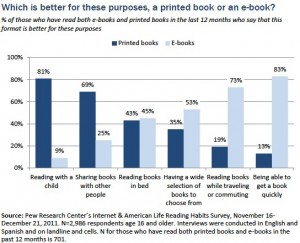The Pew Internet and American Life Project has recently published a study about the current trend in electronic reading. Their findings signal impressive gains for the Kindle and eReading in general over the past year. It can now be said with some degree of reliability that at least one in five Americans have read a book on a device designed for reading in the past year and nearly 30% of American adults now own an electronic reading device.
There is reason to be excited about this if you’re a fan of the Kindle, but the results should also be taken with a bit of caution. For example, the definition of “device designed for reading” includes tablets like the iPad. If all we’re concerned about is eBooks getting read, then that makes no difference whatsoever. When we look at ownership levels, however, including the iPad or Kindle Fire will necessarily boost the numbers by including people who have no interest in reading on their multi-function tablet.
If we do look at eBook consumption alone, regardless of the device, the numbers are even better. Pew indicates that 43% of Americans 16 and older have read an either an eBook or some other long-form publication in the past year. This includes consumption via PC, Tablet, eReader, Cell phone, and anything else with a screen that might have been handy.
Kindle users are also more likely to purchase their books than those sticking to paper. The report indicates that readers of electronic books are far more likely to buy than borrow, even when libraries are now available, and are generally more likely to say that they prefer book ownership as a rule.
These readers are more likely than their paper-loving counterparts to have read extensively over the past year as well. Readers who take advantage of options like the Kindle report an average of 24 books read per year compared to the 15 of those who don’t engage with electronic texts. This may be specific to eReaders like the Kindle, since the report also indicates that a similar disparity did not show up when comparing tablet user reading habits to non-eReader reading.
 This is not the end of the printed word, of course. Print books still account for the overwhelming majority of reading material being consumed. There have been large enough spikes in Kindle use lately to indicate the comparison might be more equal soon, but print still has its place. While most people who use eReaders reported that they prefer eBooks for a variety of reasons, print was still the desired format when talking about children’s books and book lending. The latter point is especially obvious since publishers have forced lending restrictions onto eBooks, but it is a factor nonetheless.
This is not the end of the printed word, of course. Print books still account for the overwhelming majority of reading material being consumed. There have been large enough spikes in Kindle use lately to indicate the comparison might be more equal soon, but print still has its place. While most people who use eReaders reported that they prefer eBooks for a variety of reasons, print was still the desired format when talking about children’s books and book lending. The latter point is especially obvious since publishers have forced lending restrictions onto eBooks, but it is a factor nonetheless.
The thing that best sums this up is probably the demographics. While not specific to the Kindle, eReading was measured as fairly even across the board. Men and women are roughly equally likely to have read something electronically. All income groups show at least 20% to the same question. The only real areas lagging behind in adoption are among those with a high school level education or below and readers over age 65. Even in those groups the numbers are higher than ever before, which Pew attributes to the low price of the now <$80 Kindle.